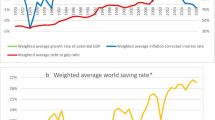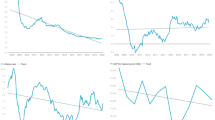Abstract
This paper presents a model of the term structure for an open economy. A flexible VAR approach is used to model macroeconomic growth, inflation, short rate and the yield spread. Then the term structure is built given restrictions implied by the no-arbitrage condition. Contrary to previously proposed macrofinance models of the term structure, the model suggested here explicitly accounts for financial and real spillovers between economies. As documented in the paper, foreign macroeconomic factors contain a lot of information about the domestic term structure of yields. Put to data, the model explains the dynamics of yields very well. It provides better out-of-sample forecasting results than the closed economy models. Openness induces more variability in the estimated term premia of yields with shorter maturities.
Similar content being viewed by others
References
Andrews DWK, Ploberger W (1994) Optimal tests when a nuisance parameter is present only under the alternative. Econometrica 62: 1383–1414
Ang A, Piazzesi M (2003) A no-arbitrage vector autoregression of term structure dynamics with macroeconomic and latent variables. J Monet Econ 50: 745–787
Ang A, Piazzesi M, Wei M (2006) What does the yield curve tell us about GDP growth?. J Econom 131: 359–403
Assenmacher-Wesche A, Pesaran MH (2008) A VECX model of the Swiss economy. CESifo Working Paper Series 2281, CESifo Group Munich
Bauer GH, de los Rios A (2012) An international dynamic term structure model with economic restrictions and unspanned risks. Bank of Canada Working Paper 2012-5
Black F (1995) Interest rates as options. J Financ 50: 1371–1376
Dai Q, Singleton KJ (2000) Specification analysis of affine term structure models. J Financ 55: 1943–1978
Dees S, di Mauro F, Pesaran MH, Smith LV (2007) Exploring the international linkages of the Euro Area: a global VAR analysis. J Appl Econom 22: 1–38
Dewachter H, Lyrio M (2006) Macrofactors and the term structure of interest rates. J Money Credit Bank 38(1): 119–140
Diebold FX, Li C (2006) Forecasting the term structure of government bond yields. J Econom 130: 337–364
Diebold FX, Rudebusch GD, Aruoba SB (2006) The macroeconomy and the yield curve: a dynamic latent factor approach. J Econom 131: 309–338
Diebold FX, Li C, Yue VZ (2008) Global yield curve dynamics and interactions: a dynamic Nelson–Siegel approach. J Econom 146: 351–363
Duffee GR (2002) Term premia and interest rate forecasts in affine models. J Financ 57(1): 405–443
Duffie D, Kan R (1996) A yield-factor model of interest rates. Math Financ 6: 379–406
Elliot G, Rothenberg TJ, Stock JH (1996) Efficient tests for an autoregressive unit root. Econometrica 64: 813–836
Engle RF, Hendry DF, Richard JF (1983) Exogeneity. Econometrica 51: 277–304
Exterkate P, van Dijk D, Heij C, Groenen PJF (2011) Forecasting the yield curve in a data-rich environment using the factor-augmented Nelson–Siegel model. J Forecast. doi:10.1002/for.1258
Favero CA, Niu L, Sala L (2012) Term structure forecasting: no-arbitrage restrictions versus large information set. J Forecast 31:124–156
Galesi A, Sgherri S (2009) Regional financial spillovers across Europe: a global VAR analysis. IMF Working Paper, WP/09/23
Garratt A, Lee K, Pesaran MH, Shin Y (2006) Global and national macroeconometric modelling: a long-run structural approach. Oxford University Press, Oxford
Granger CWJ, Lin JL (1995) Causality in the long run. Econom Theory 11(3): 530–536
Hansen BE (1992) Tests for parameter instability in regressions with I(1) processes. J Bus Econ Stat 10(3): 321–335
Hiebert P, Vansteenkiste I (2007) International trade, technological shocks and spillovers in the labour market; a GVAR analysis of the US manufacturing sector. ECB Working Paper Series, No. 731
Hördahl P, Tristani O, Vestin D (2006) A joint econometric model of macroeconomic and term-structure dynamics. J Econom 131: 405–444
Johansen S (1992) Cointegration in partial systems and the efficiency of single-equation analysis. J Econom 52(3): 389–402
Johansen S (1995) Likelihood-based inference in cointegrated vector autoregressive models. Oxford University Press, Oxford
Joslin S, Singleton KJ, Zhu H (2011) A new perspective on Gaussian dynamic term structure models. Rev Financ Stud 24:926–970
Koop G, Pesaran MH, Potter SM (1996) Impulse response analysis in nonlinear multivariate models. J Econom 74(1): 119–147
Kozicki S, Tinsley PA (2001) Shifting endpoints in the term structure of interest rates. J Monet Econ 47: 613–652
Mackinnon JG, Haug AA, Michelis L (1999) Numerical distribution functions of likelihood ratio tests for cointegration. J Appl Econom 14: 563–577
Mitchell J, Smith RJ, Weale MR, Wright S, Salazar EL (2005) An indicator of monthly GDP and an early estimate of quarterly GDP growth. Econ J 115: F108–F129
Moench E (2008) Forecasting the yield curve in a data-rich environment: a no-arbitrage factor-augmented VAR approach. J Econom 146: 26–43
Nelson CR, Siegel AF (1987) Parsimonious modeling of yield curves. J Bus 60(4): 473–489
Nyblom J (1989) Testing for the constancy of parameters over time. J Am Stat Assoc 84: 223–230
Pagan AR, Pesaran MH (2008) Econometric analysis of structural systems with permanent and transitory shocks. J Econ Dyn Control 32: 3376–3395
Pesaran MH, Shin Y (1998) Generalized impulse response analysis in linear multivariate models. Econ Lett 58: 17–29
Pesaran MH, Shin Y (2002) Long-run structural modelling. Econom Rev 21(1): 49–87
Pesaran MH, Shin Y, Smith RJ (2000) Structural analysis of vector error correction models with exogenous I(1) variables. J Econom 97: 293–343
Pesaran MH, Schuermann T, Weiner SM (2004) Modeling regional interdependencies using a global error-correcting macroeconomic model. J Bus Econ Stat 22: 129–162
Ploberger W, Kraemer W (1992) The CUSUM test with OLS residuals. Econometrica 60(2): 271–285
Quandt RE (1960) Tests of hypotheses that a linear system obeys two separate regimes. J Am Stat Assoc 55: 324–330
Salazar EL, Smith RJ, Weale MR (1997) Interpolation using a dynamic regression model: specification and Monte Carlo properties. NIESR, Discussion Paper No. 126
Spencer P, Liu Z (2010) An open-economy macro-finance model of international interdependence: The OECD, US and the UK. J Bank Financ 34: 667–680
Vansteenkiste I (2007) Regional housing market spillovers in the US: lessons from regional divergences in a common monetary policy setting. ECB Working Paper Series, No. 708
Author information
Authors and Affiliations
Corresponding author
Rights and permissions
About this article
Cite this article
Traczyk, A. Financial integration and the term structure of interest rates. Empir Econ 45, 1267–1305 (2013). https://doi.org/10.1007/s00181-012-0652-7
Received:
Accepted:
Published:
Issue Date:
DOI: https://doi.org/10.1007/s00181-012-0652-7




